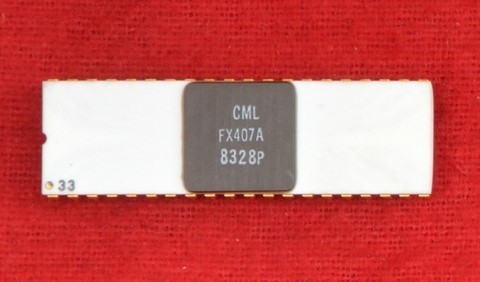FX407 Selcall Encoder
Features
- Digital Tone Filters
- Sinewave Output
- Group Call Facility
- Automatic Transpond Facility
- Pre-Programmed Frequencies
- Direct Decimal Coding
- Constant Bandwidth
- Operates in High Noise Conditions
Description
These MOS/LSI monolithic circuits are fully operational 5-tone sequential code decoders/encoders, designed for use in selective calling systems using International Frequency Standards. Each device incorporates tone filters and tone generator circuits on chip and is pre-programmed to the 11 tone frequencies specified by the appropriate standard. A 12th frequency is included which allows group calling functions to be carried out using groups of 10, 100 or 1000 receivers. The FX407A & S are programmed for CCIR tones, the FX507A & S are programmed for ZVEI tones and the FX607N is programmed for NATEL tones. The 'S’ versions of the 407/507 can decode input tones of unequal lengths.
Careful attention has been paid to operation of the tone decoders under high noise signalling conditions and specially developed digital filtering techniques are employed which permit operation under adverse signal to noise ratios. The filter circuits have a constant bandwidth over a wide dynamic signal range.
General Operation
Code programming is performed by external pin linking (direct decimal coding) and up to 100,000 codes can be programmed in this manner. Coding can be varied for receive and transmit functions and facilities are included for automatic transponding of a reply code, on receipt of the correct Address. When transmitting tones, the device generates a pseudo-sinewave consisting of incrementally stepped output levels. The output waveform has a low harmonic content and is suitable for direct modulation of transmitters.
A call number (Address code) is programmed by linking the Digit Sequence switches, S1 thro' S5, to the required Tone Digit Select inputs, 0 thro' 9. A choice of 2, 3, 4 or 5 tone call numbers may be programmed. A common code, or different codes, can be programmed for receive and transmit functions. The decoder gate period, i.e. the maximum time allowed for receipt of consecutive digits in the Address code, is set to the required value by components RS CS.
On receipt of the preset code, the decoder Address output is switched ON. The switch is latched ON until manually reset by open circuiting the Reset pin, alternatively, connecting a resistor/capacitor to the Reset pin causes automatic turn-off after a predetermined time has elapsed.
In transmit mode, the programmed code is sent once for each TX Enable input instruction (1—>0 logic level). Tones are transmitted in uninterrupted sequence until the code is completed, the duration of each tone being set by components RT CT. Each code transmission is preceded by an adjustable delay interval, set by components RD CD, to allow special user timing rules to be met.
By permanently grounding (VSS) the TX Enable pin, automatic transponding is obtained. i.e. the encoder section transmits each time the decoder receives the correct address. No transpond occurs when a Group code is received.
5-tone Group calling is obtained by connecting the output of a FX-105 single tone filter switch, tuned to the 12th tone 'G', to the Group Initiate logic input. Provided the input code contains the correct first two digits of the Address, inclusion of the 'G’ tone at appropriate points in the remaining digits activates decoders in groups of 10, 100 or 1000.
Decode and encode tone frequencies are obtained by dividing a high frequency clock (VCO) which is locked to a multiple of a low frequency reference (VCM).
The Tone Digit Select inputs are logic gates which insert correct division factors for the selected tone, absolute accuracy is determined by the VCM.
Tone Frequencies
CCIR: 1121 1200.5 1278 1357 1444 1541 16-38 1747 1856.3 1983 2113 2401
ZVEI: 1057.5 1163 1269 1402 1530 1665.5 1828 2001 2203 2403 2601 2796
NATEL: 631 697 770 852 941 1040 1209 1336 1477 1633 1805 1995
